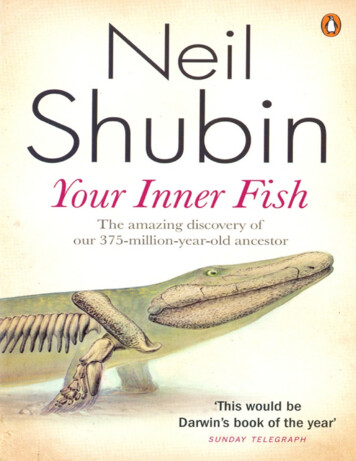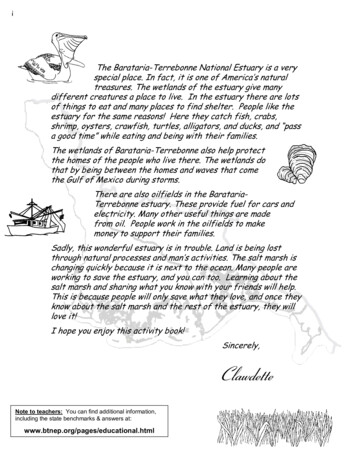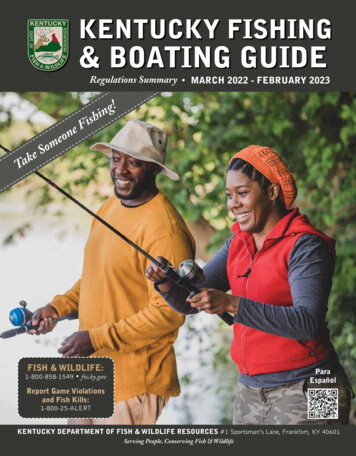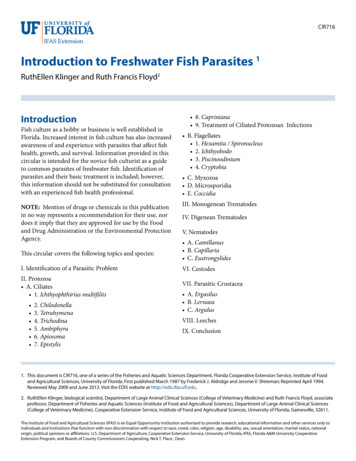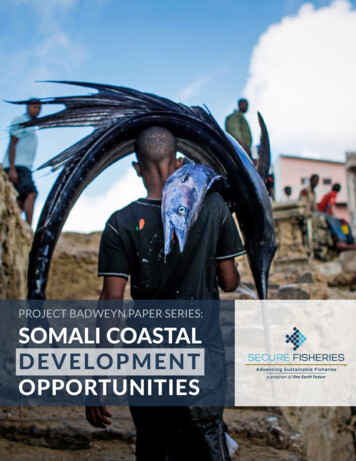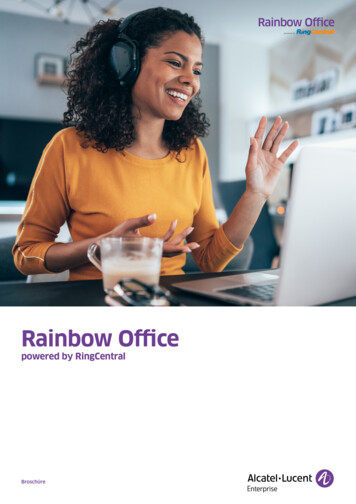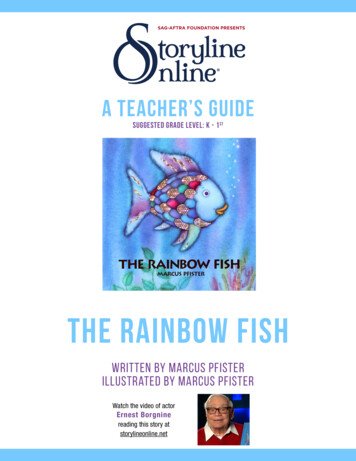
Transcription
a teacher’s guidesuggested grade level: K - 1 stthe rainbow fishwritten by marcus pfisterillustrated by marcus pfisterWatch the video of actorErnest Borgninereading this story atstorylineonline.net
about this storySYNOPSISThe Rainbow Fish is an award-winning book about a beautiful fish who finds friendship and happiness when he learnsto share. The book is best known for its morals about the value of being an individual and for the distinctive shiny foilscales of the Rainbow Fish.THEMES IN THE STORYKindness, Sharing, Giving/Helping Others, FeelingsPAGE 2 A teacher’s GUIDE the rainbow fish 2018 SAG-AFTRA FOUNDATIONAbout This Guide: The purpose of this guide is to enhance the ELA curriculum by providing quality children’s literature to engagestudents in listening to expressive read alouds. Suggested story related activities are aligned with ELA Common Core Standards.
reading and writingSuggested grade level: K - 1 stela common core standardReading Literature: Students read and respond to works of literature with emphasis on comprehension, makingconnections among ideas and between texts with focus on textural evidence. Standards listed below are forkindergarten and first grades.before viewingStandards:CCSS.SL.K .1, CCSS.SL.1.1Objective:Tap knowledge and build background to prepare for reading the story.Procedure:Build background for students by discussing the following with students:FISHWhat are some kinds of fish that you know? Can you describe them?What facts do you know about fish?SHARINGWhy is it nice to share? How does it make us feel if a friend doesn’t share with us?Why is it sometimes hard to share?during viewingFocus:CharactersStandards:CCSS.SL.K.2, CCSS.SL.1.2, CCSS.RL.K.1, CCSS.RL.1.1Objective:Students will listen to the story and answer teacher posed questions appropriately.Procedure:Stop story at appropriate parts to ask questions or pose prompts:What was so special about Rainbow Fish?What did Rainbow Fish do to upset the little blue fish? What does little blue fishdo that tells us he’s upset?Why was Rainbow fish the loneliest fish in the ocean? How did he feel?Why didn’t Rainbow fish want to give away his beautiful scales?How did Rainbow Fish feel at the end of the story? Why?PAGE 3 A teacher’s GUIDE the rainbow fish 2018 SAG-AFTRA FOUNDATIONAbout This Guide: The purpose of this guide is to enhance the ELA curriculum by providing quality children’s literature to engagestudents in listening to expressive read alouds. Suggested story related activities are aligned with ELA Common Core Standards.
after viewingStandards:CCSS.RL.K.3, CCSS.RL.1.3Objective:Students will identify characters, setting, and major events in the story.Materials:Story Element Graphic OrganizerGoogle It!: “Story Elements Graphic Organizer” to find a worksheet just right for your class.Procedure:Step 1:Show the cover of The Rainbow Fish and ask students:Who are the characters in the story?Where does the story take place? Explain that this is called the setting of a story.Step 2:Explain to students that they will review the story, but this time without the words. They will lookat the pictures and explain what is happening in the story. Turn off the sound and stop the storyperiodically to allow students to explain what is happening to their partner.Step 3:After watching the video, call on students to answer the following questions:What happened at the beginning of the story?What was the problem? How did this make the characters feel?How was this problem solved? How did the characters feel now?How does the story end?Step 4:Distribute the Story Element Graphic Organizer and have students complete.reading responseStandards:CCSS.RL.K.1, CCSS.RL.1.1, CCSS.RL.1.2Objective:Students will identify the lesson in the story, The Rainbow Fish.Materials:Sentence StripsProcedure:Step 1:Have students orally retell the story.Step 2:Ask students: What did Rainbow Fish learn?Step 3:Allow time for discussion.Step 4:Give a sentence strip to each student. Have them write an answer to the question. As an option,use the sentence starter below:Sentence Starter: Rainbow Fish learned .PAGE 4 A teacher’s GUIDE the rainbow fish 2018 SAG-AFTRA FOUNDATIONAbout This Guide: The purpose of this guide is to enhance the ELA curriculum by providing quality children’s literature to engagestudents in listening to expressive read alouds. Suggested story related activities are aligned with ELA Common Core Standards.
writing - journal entryStandards:CCSS.W.K.3, CCSS.W.1.3Objective:Students will write a narrative piece using grade appropriate sentence structure and spelling.Writing Prompt: Talk about a time when you were a good friend.Materials:Writing toolsProcedure:Step 1:Refer to Friendship activity to stimulate discussion on being a good friend.Step 2:Allow time for students to share their experiences on being a good friend.Step 3:Post and read prompt to students. Complete writing piece according to the ability of your class.PAGE 5 A teacher’s GUIDE the rainbow fish 2018 SAG-AFTRA FOUNDATIONAbout This Guide: The purpose of this guide is to enhance the ELA curriculum by providing quality children’s literature to engagestudents in listening to expressive read alouds. Suggested story related activities are aligned with ELA Common Core Standards.
across the curriculum activitiessocial studies - friendshipMATERIALS —Small paper plates (cut in half, one half per student)Large outline of a fish (big enough to fit a scale for each student)WatercolorsGlitterGlueTeacher Prep: Make a sign or cut out letters for display above fish: A Friend is .PROCEDURE —Step 1:Discuss with students:Why is friendship important?What makes a good friend? Write responses on chart paper.Step 2:Distribute a scale to each student (1/2 paper plate).Step 3:Have students write or draw something about the quality of friendship. It can be from thestudent generated list, a drawing showing friendship, a word to describe a good friend, etc.Step 4:Next, use the watercolors to paint the scale. Let it dry.Step 5:Use a sponge or brush to apply glue on scale and sprinkle glitter.Step 6:Have students share their responses before taping their scale to the large fish.SCIENCE – Fast Fish ExperimentStudents learn about surface tension in water.MATERIALS —WaterBowl (one per group/partners)Liquid soapCardboard fish (one for each student)ScissorsTeacher Prep: Use the cardboard to cut out little fish shapes.PROCEDURE —Step 1:Place students in groups.Step 2:Fill the bowl with water.Step 3:Tell students you are going to float a cardboard fish in the water. What do you think will happen?Step 4:Carefully place the cardboard fish on top of the water. Check predictions.Step 5:Explain that you are going to drop a small amount of liquid soap behind the fish’s tail. Ask students topredict what will happen.PAGE 6 A teacher’s GUIDE the rainbow fish 2018 SAG-AFTRA FOUNDATIONAbout This Guide: The purpose of this guide is to enhance the ELA curriculum by providing quality children’s literature to engagestudents in listening to expressive read alouds. Suggested story related activities are aligned with ELA Common Core Standards.
Step 6:Carefully add the drop of soap.Step 7:What happens? (the fish swims away)HERE’S THE SCIENCE —The fish swim away because the dish soap breaks the water surface tension. This allows the waterto pull the fish away from the soap. Extension: Try it with salt water.art - make a rainbow fishMATERIALS —Cone shaped coffee filtersPaint: black, purple, blue, green, yellow, redCelery sticks (about 5 per student)GlueGlitterPROCEDURE —Step 1:Give each student a coffee filter. Explain that the smaller end will be the head of the fish and the widerend will be the back end of the fish.Step 2:Dip the eraser end of a pencil in black paint. Use this to create an eye on the fish. Dip the sharpenedpencil in black paint and draw a mouth.Step 3:Dip the celery sticks into the various colors of paint to create scales on the fish. Let dry.Step 4:Spread glue on fish and apply glitter.PAGE 7 A teacher’s GUIDE the rainbow fish 2018 SAG-AFTRA FOUNDATIONAbout This Guide: The purpose of this guide is to enhance the ELA curriculum by providing quality children’s literature to engagestudents in listening to expressive read alouds. Suggested story related activities are aligned with ELA Common Core Standards.
about usabout storyline onlineThe SAG-AFTRA Foundation’s children’s literacy website Storyline Online streams imaginatively produced videosfeaturing celebrated actors to help inspire a love of reading. Storyline Online receives millions of views every monthin hundreds of countries. Visit Storyline Online at storylineonline.net.about the sag-aftra foundationThe SAG-AFTRA Foundation provides vital assistance and educational programming to the professionals of SAG-AFTRAwhile serving the public at large through its signature children’s literacy program. Founded in 1985, the Foundationis a national non-profit organization that relies solely on support from grants, corporate sponsorships, and individualcontributions to fund our programs. Visit sagaftra.foundation.storyline online brought to you byPAGE 8 A teacher’s GUIDE the rainbow fish 2018 SAG-AFTRA FOUNDATIONAbout This Guide: The purpose of this guide is to enhance the ELA curriculum by providing quality children’s literature to engagestudents in listening to expressive read alouds. Suggested story related activities are aligned with ELA Common Core Standards.
storyline online brought to you by The SAG-AFTRA Foundation's children's literacy website Storyline Online streams imaginatively produced videos featuring celebrated actors to help inspire a love of reading. Storyline Online receives millions of views every month in hundreds of countries. Visit Storyline Online at storylineonline.net.


